It is Easy to Recall How to Use a Fire Extinguisher
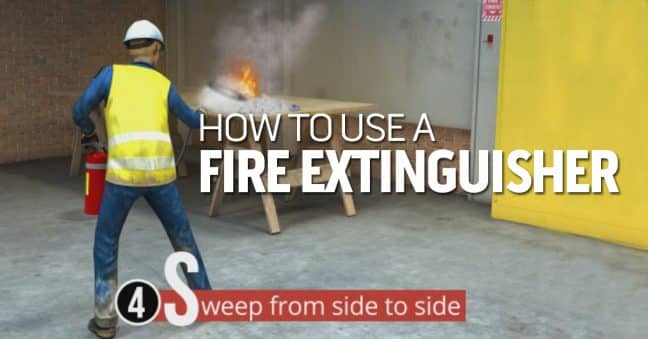
Hopefully, you'll never be in a fire and so you'll never need to know how to use a fire extinguisher.
But of course, fires DO happen. According to the U.S. Fire Administration, in a recent year there were nearly 1,300,000 fires in the US, and they caused nearly 3,300 deaths, 16,000 injuries, and nearly $12 billion in losses/damages.
So we should all hope we're never involved in a fire, but we should also learn how to use a fire extinguisher just in case.
To help, we've put together this fire extinguisher guide, which presents the proper way to select and use a fire extinguisher, and also gives you some guidance about when you should use a fire extinguisher instead of simply getting to safety and when you should evacuate if the fire gets too big despite your efforts.
When to Use a Fire Extinguisher
What's the first thing you think of when you think of fire extinguisher steps of operation? Take a moment and give it some thought.
Was your first step something like "determine if I should use a fire extinguisher or get to safety instead?" If not, you overlooked a very important decision point.
If you're involved in a fire, there may be times when it's best for you to get to safety instead of trying to fight the fire. In fact, there are times when fighting the fire may increase the danger to yourself and to others in the area.
Here is a list of things to consider before you try to fight a fire. Only stay and fight the fire if you can say "yes" to every item on the list.
- Is the fire small enough and contained enough that you can put it out safely?
- Is a fire extinguisher available and within easy reach?
- Is the fire extinguisher of the proper type to put out the kind of fire you want to extinguisher? (Read below for more on types of fires and fire extinguishers.)
- Is the extinguisher fully charged and large enough to put out the fire?
- Have you been trained to properly use a fire extinguisher?
- Can you be certain that you won't be putting yourself or others at risk if you use the fire extinguisher to fight the fire?
When thinking about how to use a fire extinguisher, it's easy to overlook the first issue, but it may be the most important of all. Don't put yourself or others at risk by attempting to follow the fire extinguisher steps listed below if it's not a fire you can put out safely.
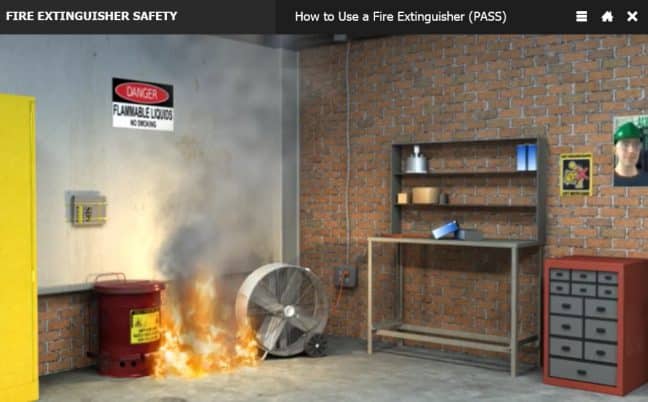
In many cases, the better and safer decision is to trigger a fire alarm, get yourself to safety and help others to safety, and make sure trained fire protection professionals are notified and on the way.
How to Use a Fire Extinguisher
In the rest of this article, we'll present additional fire extinguisher steps to follow based on the assumption that you've already determined it is safe and appropriate for you to fight the fire and that a fire alarm has been triggered.
Step 1: Know What Kind of Fire It Is (Fire Classification)
Fire mean seem simple, but in reality there are different types of fires (these are also called fire classifications). And it's important to know what type of fire you're trying to put out so that you can be sure to use the right type of fire extinguishers.
Fire experts have named the different types of fires using a 5-letter naming system (Type A, Type B, Type C, Type D, and Type K). The type of fire depends on what the fire is burning.
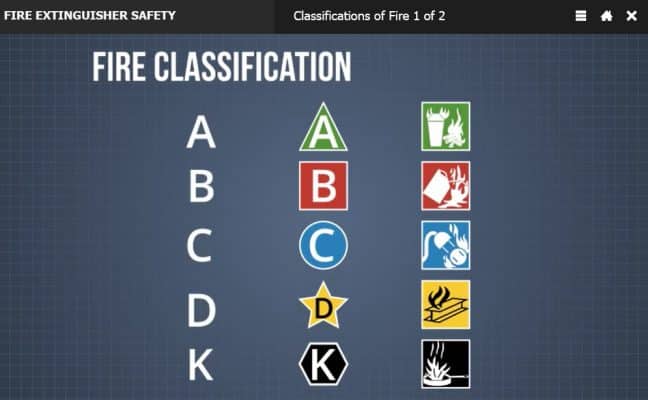
The table below explains these different types of fires. Note that these fire types are also known as fire classes.
| Type of Fire | Description of Fire |
|---|---|
| Type A | Fires involving wood, paper, cloth, rubber, and many plastics. |
| Type B | Fires involving flammable liquids and gases including gasoline, solvents, propane, and paints. |
| Type C | Fires involving energized electrical equipment, including fuse boxes, wiring, control panels, computers, copiers, machines, and appliances. In short, anything plugged into electricity. |
| Type D | A fire involving metals, including combustible powders, shavings, or flakes of metals such as magnesium, titanium, potassium, and sodium. |
| Type K | Fires involving cooking oils and fats often used in commercial kitchens. |
Remember that knowing what's burning, and therefore knowing the type of fire, is important so you'll use the right type of fire extinguisher.
Additional Tips for this Step of our Fire Extinguisher Guide
- We mentioned this in the earlier section, but when you're looking at the fire to determine what type of fire it is, make sure it's not too big to fight and make sure you've got a way to get away if things get worse.
- If you're like almost every living person alive, you'll forget the five fire types listed above sometime today or tomorrow (fire experts excepted, of course). If you CAN remember them, great. But if not, it's a good idea to put a list of the fire types like the one above near fire extinguishers.
Step 2: Get the Right Type of Fire Extinguisher
Once you know the type of fire, check to see if you have the right kind of fire extinguisher to put out that fire.
For example, if you've got a Type A fire, you want a fire extinguisher that's capable of putting out Type A fires.
So how do you know the type or types of fires that a fire extinguisher can put out?
The easiest way is to look at the label on the fire extinguisher. It will tell you what type of fire (or fire class) the fire extinguisher can safely put out.
Some extinguishers can only put out one type of fire. For example, you may see a fire extinguisher with an "A" rating. You should only use that type of extinguisher on Type A fires. On the other hand, some fire extinguishers can put out several different types of fires. For example, you may see a fire extinguisher with an A, B, and C rating. You could use that type of fire extinguisher to put out Type A, Type B, and Type C fires.
The best way to know what type of fire extinguisher you have is to look at the label, as shown below.
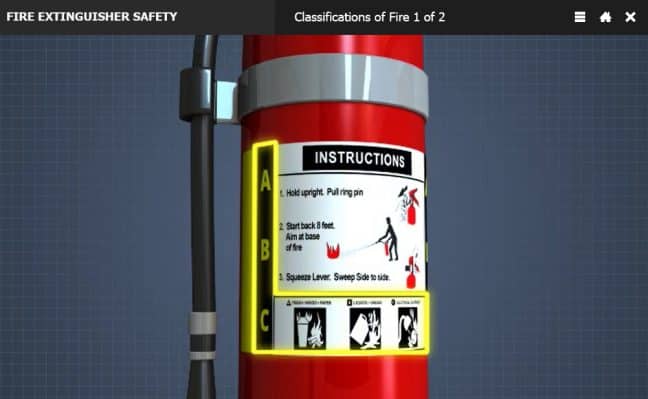
The important thing to remember from this section is to make sure the fire extinguisher you want to use has a label saying it can safely extinguisher the type of fire you're trying to extinguish.
The Fire Equipment Manufacturer's Association has more information if you'd like to learn even more about types of fire extinguishers.
Additional Tips for this Step of our Fire Extinguisher Guide
We mentioned this earlier too, but when you're checking to make sure you've got the right kind of fire extinguisher, make sure the extinguisher is fully charged and that it's big enough for the fire you want to put out.
Step 3: The PASS Method for Using a Fire Extinguisher
Once you know the type of fire and have selected an appropriate fire extinguisher, you'll want to use the extinguisher to put the fire out.
But not everyone knows how to use an extinguisher. Fortunately, there's a simple, 4-step method you can follow to use a fire extinguisher properly. The fire extinguisher steps method is known as PASS, and each letter in the word PASS (P, A, S, and S) stands for the first word of each step. The PASS method works for many common fire extinguishers.
We've explained the four steps of the PASS method for using a fire extinguisher below.
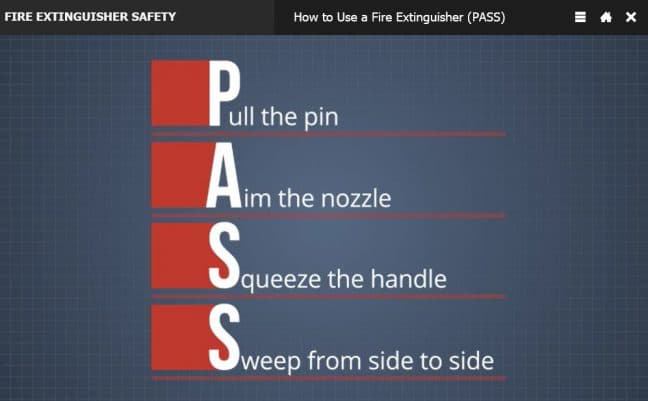
PASS Step 1: PULL the pin
Many fire extinguishers have a pin near the handle at the top like the one shown in the image below. Begin by removing that pin. In some cases, instead of a pin there's been a lock latch you'll have to release or a puncture level you have to press.
Because these steps can differ, you'll want to learn how the fire extinguishers at your work or home operate BEFORE you have a fire.
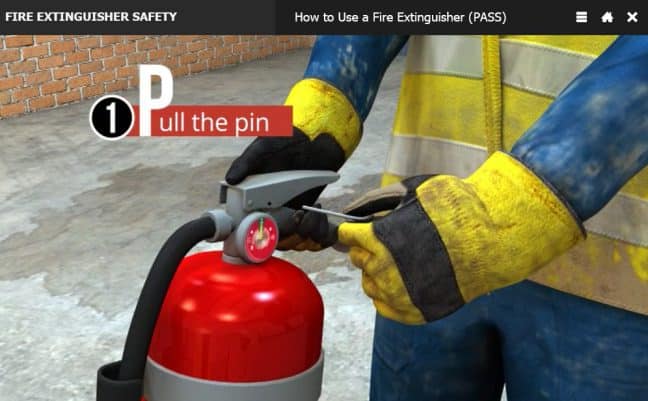
PASS Step 2: AIM the nozzle, horse, or hose
Aim the nozzle, horn, or hose of the fire extinguisher at the base of the fire (this means the bottom, where the stuff that's burning is located).
A common mistake is to aim into the flames. This won't put out the fire.
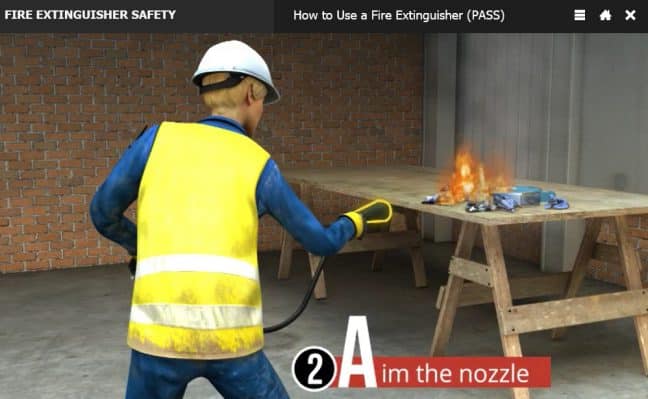
PASS Step 3: SQUEEZE the handle
Next, squeeze the handle of the fire extinguisher.
This will cause the fire extinguisher to begin working.
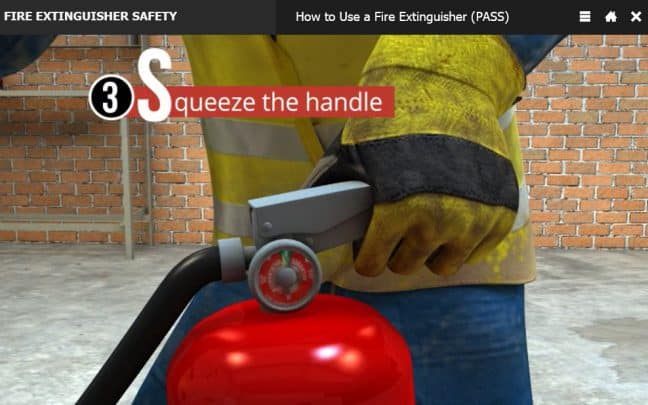
PASS Step 4: SWEEP from side to side at the base of the fire
Use a sweeping motion from side to side to cover the base of the fire.
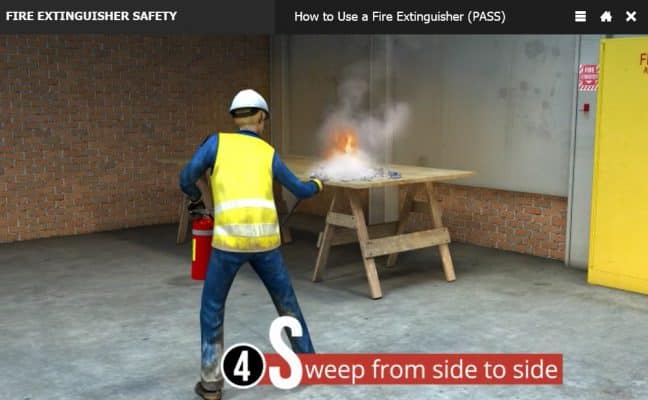
Continue extinguishing the fire until the fire is completely out. After the fire appears to be out, watch the area in case the fire breaks out again, and repeat use of the extinguisher if necessary.
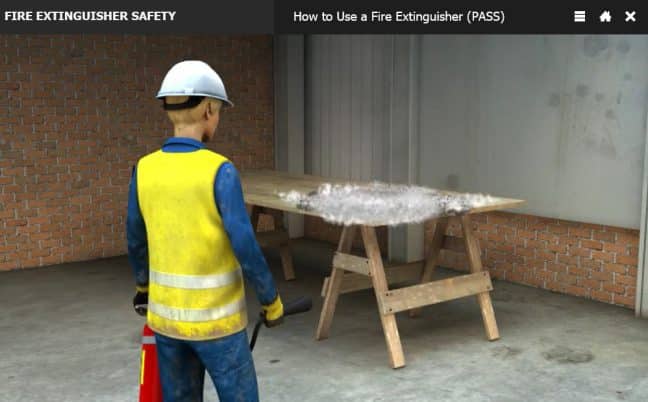
The video below from our Fire Extinguisher Safety Online Training course demonstrates the entire PASS method of how to use a fire extinguisher.
Additional Tips for this Step of our Fire Extinguisher Guide
- Although the PASS method works for many fire extinguishers, it's not the right method for all. Some fire extinguishers require that you apply the fire suppressant that shoots out of the extinguisher in a top-down, rain-like manner (instead of aiming at the base and sweeping). As always, the best thing to do is know exactly what kind of fire extinguisher you've got at home or work and exactly how to use it before you need to use it. It's also not a bad idea to post large, easy-to-read operating instructions near the fire extinguisher.
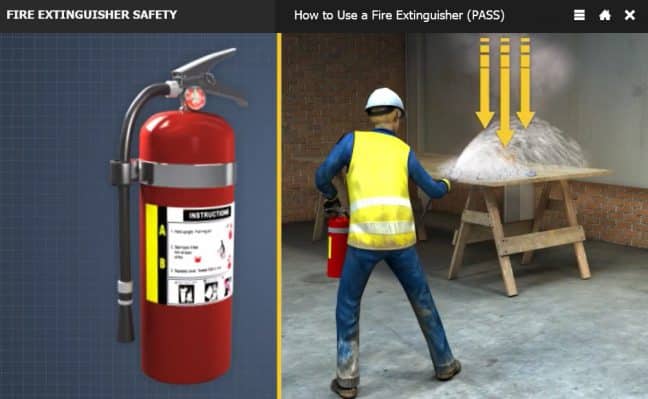
- Reading an article about how to use fire extinguishers helps, and watching an online fire extinguisher safety training course helps even more, but it's still a good idea to get some real hands-on training if you can. See if you and your safety manager at work can arrange for fire extinguisher practice in a safe, controlled environment as part of your general safety training.
Step 4: When to Quite Fighting the Fire and Evacuate the Fire Scene
When you're actively fighting the fire, you should remember there may be cases when you'll have to give up, quit fighting the fire, and evacuate the fire area for your own safety.
Here are some reasons to quit fighting a fire and to evacuate immediately:
- The fire is spreading too quickly
- The fire could block your only exit
- The fire is too large
- The fire is so hot you can't get close enough to fight it effectively (10-15 feet)
- You've had to get down on your knees and/or crawl because you can't see well otherwise, because of high temperatures, or because of smoke
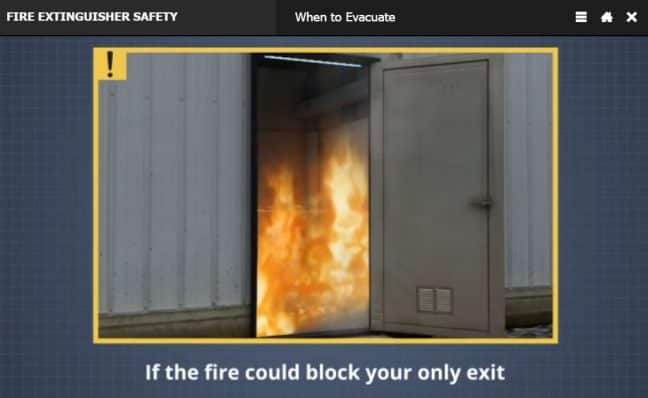
Once you've left the fire area, make sure a fire alarm has been triggered (if it hasn't already) and fire fighting professionals are on the way.
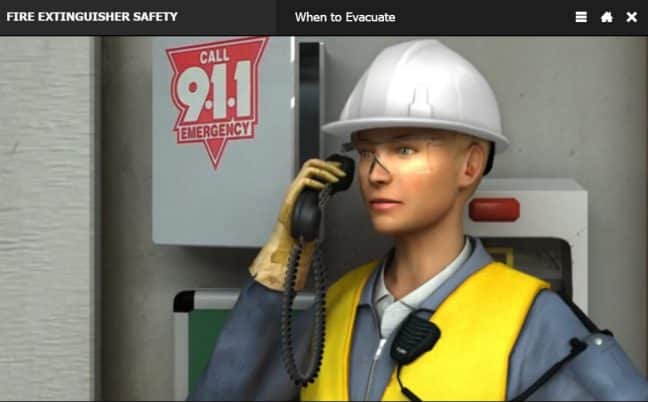
Additional Articles about Fire Extinguishers
In addition to this article, you may find the following articles related to fire safety and fire extinguishers helpful:
- OSHA Fire Extinguisher Safety Training Requirements
- Types of Fire Extinguishers - Which One To Buy
- OSHA Fire Extinguisher Mounting Height, Placement & Signage Requirements
- How to Pass an OSHA Fire Extinguisher Inspection
Finally, you may want to consider our online fire extinguisher safety training course.
Conclusion: How to Use a Fire Extinguisher--A Fire Extinguisher Guide
We hope you've found this explanation of how to use a fire extinguisher helpful and informative. Remember this article is a good start but additional training and preparation is wise.
In addition, become familiar with the fire hazards, fire precautions, and fire extinguishers at your workplace or home.
Source: https://www.vectorsolutions.com/resources/blogs/how-to-use-a-fire-extinguisher-step-by-step-guide/
0 Response to "It is Easy to Recall How to Use a Fire Extinguisher"
Post a Comment